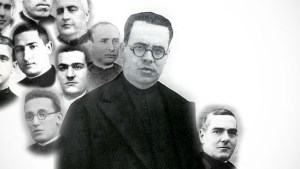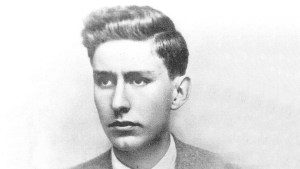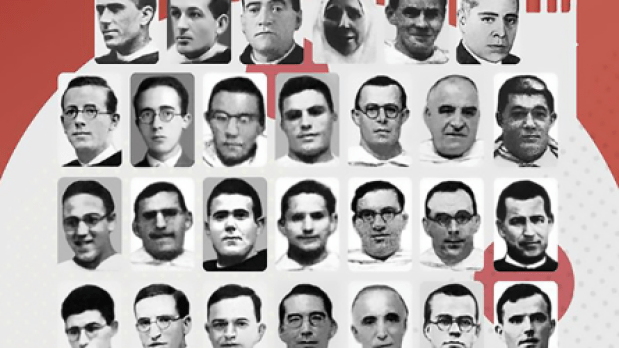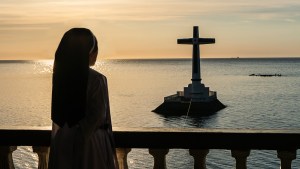Next Saturday, June 18, 2022, at the Cathedral of Seville, Spain, 27 early 20th-century Dominican martyrs of the Spanish Civil War will be beatified.
The soon-to-be-blessed include 25 Dominican friars martyred in Almagro and in Almeria, as well as a Dominican layman—a renowned journalist who also suffered martyrdom in Almeria—and a Dominican nun from Huescar, who will become the second Spanish Dominican nun to be beatified in the history of the Order. The three cities where the martyrdoms took place are all located in southern Spain.
These martyrs join with more than 2,000 more who have already been beatified. Nearly a dozen have been canonized, and thousands more still have their causes underway. More than 6,500 priests and religious were killed during the war.
History of the martyrdom of the friars of Almagro
The Dominican order describes their story on the order’s website in Spanish. It relates how on July 21, 1936, three days after the beginning of the Spanish Civil War, several members of the Ateneo Libertario (an anarchist workers’ organization that sided with the leftist Republican Faction) set fire to the Church of the Mother of God. The church was visible from their friary, so the Dominicans hastened to try to save the church from the flames. However, the militants contemptuously forced them away. The mayor, who didn’t want violence in his jurisdiction, then asked the friars to leave the town, but they refused. That same night, the militants searched the friary for weapons.
The next day they showed up again at the friary and threatened the Dominicans, saying they would burn the friary down with them inside. The mayor of Almagro visited the religious and insisted repeatedly that it would be better for the friars to leave, assuring them of safe passage out of town. By July 25, they had no choice but to abandon the friary, although most found lodging in houses in the town rather than abandon the region. Eventually they were rounded up, because the anarchists considered them “dangerous.”
Some accepted the offer of safe passage, but were then eventually killed by Republican militants before reaching safety in areas under control of the Nationalist Faction. In the end, those who had remained in Almagro were imprisoned and martyred. First they were told that they were being taken for interrogation, but it soon became clear this was a lie. The younger friars prayed the rosary and wept. The cook, Friar Arsenio, took out a crucifix and they all began to pray. Their captors tied them up two by two and took them to a field less than two miles from Almagro, where they were all killed.

History of the martyrdom of the Dominicans in Almeria
The Dominican website recounts that, as had happened with the friars of Almagro, those of Almeria were forced to abandon their friary. They took refuge in the homes of friends and relatives, but one by one they were arrested. Almeria being a port city, ships—the Astoy-Mendi and the Segarra—were used to hold the religious, although some were first tortured at the police station. During the month of September, three of them were shot nearby in La Lagarta and Pozos de Tabernas (Almeria) and two of them were shot by the walls of the cemetery of Almeria.
Journalist-martyr
Fructuoso Pérez, a well-known Catholic journalist and Dominican layman, was martyred along with them. He was arrested at his home on July 26, 1936. He was taken first to the police station and from there to an improvised prison in one of the city’s convents. Like the Dominican friars, a week later he was taken to the Segarra. Less than two weeks later, he was taken out onto nearby Garrofa Beach and executed. His body, along with those of the other martyrs killed at that location, was thrown into the sea.
The bodies soon washed ashore again, so they were buried on the beach, where they remained until the war ended. They were eventually moved to unmarked graves in the cemetery of Almeria.

Isabel Sanchez Romero: sick, elderly … and heroic
The story of Isabel Sanchez Romero is one of full dedication. She was born in Huéscar (Granada) and there she would enter the Dominican convent of the Mother of God in Huéscar, at the age of 17.
Her companions always said of her that she was humble, obedient, quiet, and hardworking. She patiently lived with a rare disease that covered her body with sores. She never complained, and she willingly took on whatever responsibilities this rare disease allowed her. Her pain would give her strength for her later martyrdom.
The nuns soon had to flee from the convent of Huéscar, and one day the militiamen appeared at the house where Sister Isabel, then 76 years old, was hiding. They took her to the prison and tried to force her to blaspheme by threatening her with death. She did not give in, and was cruelly beaten and left lying on the floor half dead. Despite her age and poor health, she had the strength to get through that night. The next morning she was put on a truck to be taken to the gates of the cemetery. There she would see her nephew killed, and was again asked to blaspheme. She refused.
At the end, the Dominican website says, they placed her head on a stone and used another stone to crush her skull.
The beatification will be streamed here:


